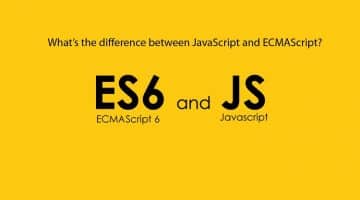ESNext is the future version of ECMAScript which is yet to be released. ECMA script and JavaScript is not the same thing. ECMA script is a language based on JavaScript. International ECMA organization ensures that JavaScript written for one company browser would work in all companies’ browsers and also maintain the standard for the language. ECMAScript is the standard name for JavaScript. Many developers are fear for using new features of ECMA that are why the new features of ECMAScript can be added to JavaScript engines so developers can hold of them with extra features. The features of ESNext have not been officially added to JavaScript engines if you want to use that features you have to use transpiler to convert the ESNext code to supported form that browsers accept. You can find freelancers who have Knowledge of ECMAScript.
JavaScript and ECMAScript both are in combine work on following features.
Babel
Babel has an interactive shell that you see what your ESNext code compile to. Babel is the best feature of JavaScript. It is compiler support ES2015 and ES2016 features.
Traceur
Traceur is documentation created and maintained by team Google.
ESNext
ENext is mainly for accolade for Babel, and it is easy to use when getting started and the website has to perform some test code.
JavaScript belongs to Sun Microsystems, but when it came to standardize the different language name had to be used. ECMA International hosted the ECMA script and chose this name. JavaScript is interchanging with ECMAScript. The term ECMA is used to define the version of a language. Mozilla implements a both JavaScript and ECMAScript. In 1999 ECMA International released the third version which is called ECMA3 or ECMA-262. ECMA-262 is an official specification of ECMAScript. In 2009 ECMA international release fifth version which is ECMA5 and this version is used to create web apps. In 2014 ECMA technical committee 39 is the group of people who develop ECMA-262 standard these features are mainly for Browsers. You can hire freelancers working in this sector, as it is always difficult to get employees in niche skills.
In the third edition consist of some bug that’s why the third version becomes a failure. The Fourth version of ECMA-262 is out in 1999. An es4 proposal backed in August 2008. The included features are in 4th versions such as classes, a module system, Generators and iterators and algebraic data types. This version also supports JSON encoding and decoding that is very useful for finding bugs.
The fifth version of ECMA focuses on security and library updated with a large focus on compatibility. The Yahoo, Microsoft, Google and other 4th edition formed their subcommittee in this version. ECMAScript 4 supported by ECMA dissenters. After sometimes there is a difference between ECMAScript and ECMA Technical Committee 39 and in July 2008 the two team create a new version that is ECMA 5. In this version, the project is full collaboration all parties and vendors would target at least two interoperable implementations before 2009. ECMA TC39 final draft was published in April 2009 and said that testing process was expected to complete in mid-July, but the fifth edition was on the market in December 2009. You can find freelancers working on JavaScript, who can work on ENext also.
The sixth edition of ECMAScript is released in 2015 so that this version also known as ECMAScript 2015. This version consists of special syntax that is more useful for writing complex applications including classes and modules, but the definition of this syntax is typically same as ECMAScript 5 strict mode. This version also includes new features such as for loops, arrow function, and binary data, math enhancement, reflection, and proxies. In the fifth version, the browser supports still incomplete. The code of ES2015 has transpailed into ES5 code which supports more consistently across the browser. Transpelling adds extra functionality to build process whereas polyfills permit extra functionality by including another JavaScript file. To enable ESNext features, you should require React.js and Ember.js option. You can also directly used in your codebase application. The version ES6 is a huge concept.
Classes:
ECMA Script is a prototype-based inheritance and has been missing OOP style classes. But ES6 version implemented the object orientated Programming style classes. All OOPS style structure came into ExtJS through JavaScript. The already build code is work just fine with ExtJS without any modification. The keyword Public and Private members got added in ES6 version.
Proxies:
JavaScript object had getters and setters for quite a while now but this work only for named member. There are many ways to describe the getter and setter for any arbitrary member name without knowing the name beforehand.
Destructuring Assignment:
It is shorthand ways which select some item from an array or object into another array or object.
Template String:
ES6 consists of some template features. You are familiar with some tempting system like Mustache and handlebars and string exclamation feature of a language.
Arrow Function:
Arrow function is also known anonymous function which is part of ES6 version. When you declare Arrow function, this keyword value is defined.
The 7th edition of ECMA it is also known as ECMA 2016 because it is published in June 2016 and adds extra features than the previous version. The extra features are the exponentiation operator “**” means this cascade the functions of classes. Now several proposals for features are added to JavaScript. These features include decorators, async-await, and static class properties all these are features of ES7 and ES2016 but it is known as ECMAScript 2016 ha not be written yet, therefore, it might not include all these features The future version of ECMA is known as ESNext. Many major web frameworks are offering some optional support for ESNext features and syntax or directly require them. This 8th edition is under the Ecma RF patent policy, and it is in the draft up to January 2017. You can hire freelancers who have complete knowledge of ECMAScript and JavaScript.
Summary:
In this article, you get Knowledge of what is ESNext and different versions of ECMAScript in detailed. ECMAScript is the standard name for JavaScript language whereas next version of ECMA script is known as ESNext.


